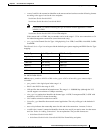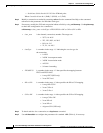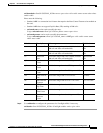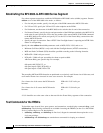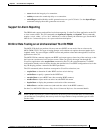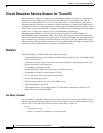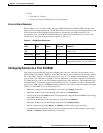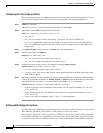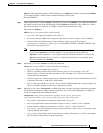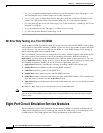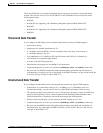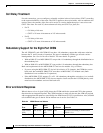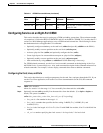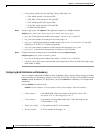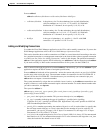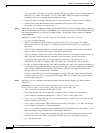
6-41
Cisco MGX 8230 Edge Concentrator Installation and Configuration
Release 1.1.31, Part Number 78-11215-03 Rev. B0, May 2001
Chapter6 Card and Service Configuration
Circuit Emulation Service Module for T3 and E3
addcon. If the application requires NSAP addressing, use addchan to add the connection and cnfchan
if you need to modify it. Refer to the command reference for the syntax.
On the CESM CLI:
Step 1 Add a connection by executing addcon. (Alternatively, you can use addchan if your application requires
the NSAP format of end-point specification.) Execute addcon at both ends of the connection—unless
the remote end-point is on port 34 of a PXM1 (see the note at the end of this step).
The syntax for addcon is:
addcon <port_num> [mastership [remoteConnId] ]
• port_num is the logical port number and is always 1.
• mastership indicates whether this end-point is the master or slave 1=master; 2=slave (default).
• remoteConnId is the identification for the connection at the slave end. The format is
switchname.slot_number.port_number.vpi.vci. For the MGX-CESM-T3 and MGX-CESM-E3, the
VPI and VCI are typically 0 or 1.
Note For the channel number, the system always returns the number 32 for the high-speed CESM.
If you execute dspchan, use channel number 32 to see details about the channel (or
dspchans—and no arguments—to see high-level details about the channel). In contrast, the
dspcon command takes the port number 1 to identify the connection even though it shows
the same information as dspchan.
Step 2 Optionally, you can use cnfcon to modify the connection.
cnfcon <port_num> <CDVT> <CellLossIntegPeriod> <bufsize>
• port_num is the port number and is always 1.
• CDVT is a tolerable variation for the arrival time of cells. For T3, the range is 125–1447
microseconds in 125-microsecond increments. For E3, the range is 125–1884 microseconds in
125-microsecond increments.
• CellLossIntegrPeriod is the amount of time a connection can be in an error condition before an alarm
is declared. The range is 1000–65535 milliseconds.
• bufsize is the egress buffer size in bytes. You can let the CESM compute the size by entering 0 for
bufsize or enter the number of bytes up to a maximum of 16224.
Step 3 Optionally, you can use cnfswparms on a BPX 8600 series switch to configure connection parameters
for the network segment of a three-segment connection. For a stand-alone application, use whatever
means are supported by the backbone switches.
cnfswparms <chan_num> <mastership> <vpcflag> <conn_service_type> (=cos)
<route_priority> <max_cost> <restrict_trunk_type> <pcr> <mcr> <pct_util>
• chan_number is the channel (connection) number and is always 32.
• mastership specifies the current end-point as master or slave: 1=master; 2=slave (default).
• vpcflag indicates whether the connection is a VPC or a VCC: 1=VPC; and 2=VCC.
• conn_service_type selects the type of service for the connection: 1=cbr; 2=vbr; 3 is not used; 4=ubr;
5=atfr; 6=abrstd; and 7=abrfst.
• route_priority is the priority of the connection for rerouting. The range is 1–15 and is meaningful
only in relation to the priority of other connections.



